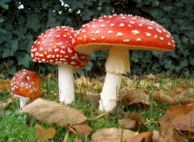
Fly Agaric |
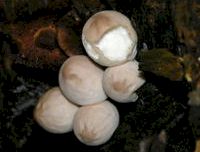
Puff Bals |
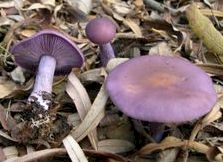
Blewits |
Without giving descriptive attention to those Mushrooms (Agarics, Boleti, and others) which are edible, and of which over a hundred may be enumerated, as beyond our purpose when treating of curative Herbal Simples, notice will be bestowed here on two productions of the Mushroom nature--the Puff Ball and the Fly Agaric,--because of their medicinal qualities.
|
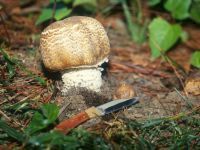
Agaricus Campestris |
It may be first briefly stated that the "Agaricus campestris", or field Mushroom, is the kind most commonly eaten in England, being highly nitrogenous, and containing much fat. This may be readily distinguished from any harmful fungus by the pink color of its gills, the solidity of its stem, the fragrant anise-like odor which it possesses, and the separability of its outer skin. Other edible Mushrooms which grow with us, and
are even of a better quality than the above, are the "Agaricus augustus" and the "Agaricus elvensis", not to mention the "Chanatrelle", said to be unapproachable for excellence. |
The Greeks were aware of edible fungi, and knew of injurious sorts which produced a sense of choking, whilst subsequent wasting of the body occurred. Athenaeus quotes an author who said: "You will be choked like those who waste after eating mushrooms." The Romans also esteemed some fungi as of so exquisite a flavor that these would be stolen sooner than silver or gold by anyone entrusted with their delivery:
"Argentum, atque aurum facile est laenamque togamque. Mittere, boletos mittere difficile est."
Mushrooms were styled by Porphry deorum filii, and "without seed, as produced by the midwifery of autumnal thunderstorms, and portending the mischief which these cause." "They are generally reported to have something noxious in them, and not without reason; but they were exalted to the second course of the Caesarean tables with the noble title 'bromatheon,' a dainty fit for the gods, to whom they sent the Emperor Claudius, as they have many since to the other
world." "So true it is he who eats Mushrooms many times, nil amplius edit, eats no more of anything."
The poisonous kinds may be commonly recognized by their possessing permanently white gills which do not touch the stem; and a thin ring, or frill, is borne by the stem at some distance from the top, whilst the bottom of the stem is surrounded by a loose sheath, or volva. If "phalline" is the active poisonous principle, this is not rendered inert by heat in cooking; but the helvellic acid of other sorts disappears during the process, and its fungi are thus made non-poisonous.
There is a popular belief that Mushrooms which grow near iron, copper, or other metals, are deadly; the same idea obtaining in the custom of putting a coin in the water used for boiling Mushrooms in order that it may attract and detach any poison, and so serve to make them wholesome.
In Essex there is an old saying:
"When the moon is at the full, Mushrooms you may freely pull; But when the moon is on the wane, Wait till you think to pluck again."
Even the most poisonous species may be eaten with impunity after repeated maceration in salt and water, or vinegar and water--which custom is generally adopted in the South of Europe, where the diet of the poorer classes largely includes the fungi which they gather; but when so treated the several Mushrooms lose much of their soluble nutritive qualities as well as their flavor. For the most part, Agarics with salmon-colored spores are injurious, likewise fungi having a rancid
or fetid odor, and an acrid, pungent, peppery taste. Celsus said: "If anyone shall have eaten noxious fungi, let him take radishes with vinegar and water, or with salt and vinegar."
Wholesome Mushrooms afford nourishment which is a capital substitute for butchers' meat, and almost equally sustaining. If a poisonous fungus has been eaten, its ill-effects may nowadays be promptly met by antidotes injected beneath the skin, and by taking small doses of strychnia in coffee.
Gerard says: "I give my advice to those that love such strange and new fangled meats to beware of licking honey among thorns, lest the sweetness of the one do not countervail the sharpness and pricking of the other." With regard to Mushrooms generally, Horace said:
"Pratensibus optima fungis Natura est; aliis male creditur."
"The meadow Mushrooms are in kind the best; 'Tis ill to trust in any of the rest."
The St. George's Mushroom, an early one, takes, perhaps, the highest place as an agaric for the table. Blewits (formerly sold in Covent Garden market for Catsup), and Blue Caps, each all autumnal species, are savory fungi to be fried. They may be served with bacon on toast.
A very old test as to the safety of Mushrooms is to stew with them in the saucepan a small carefully-peeled onion. If after boiling for a few minutes this comes out White, and clean-looking, the Mushrooms may all be confidently eaten: but if it has turned blue, or black, there are dangerous ones among them, and all should be rejected.
|

Puff Ball |
The Puff Ball (Lycoperdon giganteum bovista) grows usually on the borders of fields, in orchards, or meadows, also on dry downs, and occasionally in gardens. It should be collected as a Simple in August and September. This Puff Ball is smooth, globose, and yellowish-white when young, becoming afterwards brown. It contains, when ripe, a large quantity of extremely fine brown black powder, which is a capital
application for stopping bleeding from slight wounds and cuts. This also makes a good drying powder for dusting on weeping eruptive sores between parts which approximate to one another, as the fingers, toes, and armpits. The powder |
is very inflammable, and when propelled in a hollow cone against lighted spirit of wine on tow at the other end by a sudden jerk, its flash serves to imitate lightning for stage purposes. It was formerly used as tinder for lighting fires with the flint and steel.
When the fungus is burnt, its fumes exercise a narcotic property, and will stupify bees, so that their honey may be removed. It has been suggested that these fumes may take the place of chloroform for minor surgical operations. The gas given off during combustion is carbonic oxide.
Puff Balls vary in size from that of a moderately large turnip to the bigness of a man's head. Their form is oval, depressed a little at the top, and the color is a pure white both without and within. The surface is smooth at first, but at length cracking, and as the fungus ripens it becomes discolored and dry; then the interior is resolved into a yellow mass of delicate threads, mixed with a powder of minute spores, about the month of September.
When young and pulpy the Puff Ball is excellent to be eaten, and is especially esteemed in Italy; but it deteriorates very rapidly after being gathered, and should not be used at table if it has become stained with yellow marks. When purely white it may be cut into thick [367] slices of a quarter-of-an-inch, and fried in fresh butter, with pepper, salt; and pounded herbs, and each slice should be first dipped in the yolk of an egg; the Puff Ball will also make an excellent
omelets. Small Puff Balls are common on lawns, heaths, and pastures. These are harmless, and eatable as long as their flesh remains quite white. The Society of Amateur Botanists, 1863, had its origin (as described by the president, Mr. M. C. Cooke), "over a cup of tea and fried Puff Balls," in Great Turnstile.
Pieces of its dried inner woolly substance, with a profusion of minute snuff-colored spores, have been long kept by the wise old women of villages for use to staunch wounds and incisions; whilst a ready surgical appliance to a deep cut is to bind a piece of Puff Ball over it, and leave it until healing has taken place. In Norfolk large Puff Balls found at the margins of cornfields are known as Bulfers, or Bulfists, and are regarded with aversion.
In medicine a trituration (H.) is made of this fungus, and its spores, rubbed up with inert sugar of milk powdered, and it proves an effective remedy against dull, stupid, sleepy headache, with passive itchy pimples about the skin. From five to ten grains of the trituration, diluted to the third decimal strength, should be given twice a day, with a little water, for two or three weeks.
Sir B. Richardson found that even by smelling at a strong tincture of the fungus great heaviness of the head was produced; and he has successfully employed the same tincture for relieving an analogous condition when coming on of its own accord. But the Puff Ball, whether in tincture (H.) or in trituration, is chiefly of service for curing the itchy pimply skin of "tettery" subjects, especially if this is aggravated by washing. Likewise the remedy is of essential use in some
forms of eczema, especially in what is known as bakers', or grocers' itch. Five drops of the diluted tincture may be given with a spoonful of water three times in the day; and the affected parts should be sponged equally often with a lotion made of one part of the stronger tincture to four parts of water, or thin strained gruel. Sometimes when a full meal of the Puff Ball fried in butter, or stewed in milk, has been taken, undoubted evidences of its narcotic effects have
shown themselves.
Gerard said: "In divers parts of England, where people dwell far from neighbors, they carry the Puff Balls kindled with fire, which lasteth long." In Latin they were named "Lupi crepitum", or Wolfs' Fists. "The powder of them is fitly applied to merigals, kibed heels, and such like; the dust or powder thereof is very dangerous for the eyes, for it bath been observed that divers have been poreblind even after when some small quantity thereof hath been blown into their eyes."
This fungus has been called Molly Puff, from its resemblance to a powder puff; also Devil's Snuff Box, Fuss Balls, and Puck Fists (from feist, crepitus ani, and _Puck_, the impish king of the fairies). In Scotland the Puff Ball is the blind man's e'en, because it has been believed that its dust will cause blindness; and in Wales it is the "bag of smoke."
|

Fly Agaric |
The Fly Agaric, or Bug Agaric (Agaricus muscarius) gives the name of Mushroom to all the tribe of Fungi as used for the destruction of flies (mousches). Albertus Magnus describes it as Vocatus fungus muscarum eo quidem lacte pulverisatus interficit muscas: and this seems to be the real source of the word, which has by caprice become transmitted from a poisonous sort to the wholesome kinds
exclusively. The pileus of the Fly Agaric is broad, convex, and of a rich orange scarlet color, with a striate margin and white gills. It gets its name, as also that of Flybane, from being |
used in milk to kill flies; and it is called Bug Agaric from having been formerly employed to smear over bedsteads so as to destroy bugs. It inhabits dry places, especially birchwoods, and pinewoods, having a bright red upper surface studded with brown warts; and when taken as a poisonous agent it causes intoxication, delirium, and death through narcotism. It is more common in Scotland than in England. This Mushroom is highly poisonous, and therefore the remedial preparations
are only to be given in a diluted form. For medicinal purposes a tincture is made (H.) from the fresh fungus: and a trituration of the dried fungus powdered and mixed with inert sugar of milk also powdered. These preparations are kept specially by the homoeopathic chemists: and the use of the Fly Agaric has been adopted by the school which they represent for curatively treating an irritable spinal cord, with soreness, twitching of the limbs, dragging of the legs, unsteadiness
of the head, neuralgic pains in the arms and legs (as if caused by sharp ice), some giddiness, a coating of yellow fur on the lining mucous membranes, together with a crawling, or burning, and eruptive skin. In fact for a lamentably depraved condition of all the bodily health, such as characterizes advanced locomotor ataxy, and allied spinal degradations leading to general physical failure. Just such a totality of symptoms has been recorded by provers after taking the fungus
for some length of time in toxical quantities. The tincture should be used of the third decimal strength, five drops for a dose twice or three times a day with a spoonful of water; or the trituration of the third decimal strength, for each dose as much of the powder as will lie on the flat surface of a sixpence. Chilblains may be mitigated by taking the tincture of this Agaric, and by applying some of the stronger tincture on cotton wool over the swollen and itching parts alt
night.
"Muscarin" is the leading active principle of the Fly Agaric, in conjunction with agaricin, mycose, and mannite. It stimulates, when swallowed in strong doses, certain nerves which tend to retard the action of the heart. Both our Fly Agaric and the White Agaric of the United States serve to relieve the night sweats of advanced pulmonary consumption, and they have severally proved of supreme palliative use against the cough, the sleeplessness, and the other worst symptoms of
this, wasting disease, as also for drying up the milk in weaning. Each of these fungi when taken by mistake will salivate profusely, and provoke both immoderate, and untimely laughter. When the action of the heart is labored and feeble through lack of nervous power, muscarin, or the tincture of Fly Agaric, in a much diluted potency will relieve this trouble. The dose of Muscarin, or Agaricin, is from a sixth to half a grain in a pill. These medicines increase the secretion of
tears, saliva, bile, and sweating, but they materially lessen the quantity of urine. Belladonna is found to be the best antidote. From the Oak Agaric, "touchwood," or "spunk,"--when cut into thin slices and beaten with a hammer until soft,--is made "Amadou," or German tinder. This is then soaked in a solution of nitre and dried; it afterwards forms an excellent elastic astringent application for staying bleedings and for bed sores. The Larch Agaric is powdered, and given in
Germany as a purgative, its dose being from twenty to sixty grains.
In Belgium the Polyporus Officinalis is used medicinally as an aperient, and to check profuse sweating. By the Malays the Polyporus Sanguineus is used outwardly for leprosy.
|
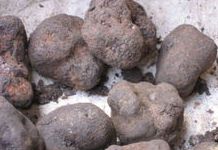
Truffles |
Truffles (Tuber cibarium) may receive a passing notice whilst treating of fungi, though they are really subterranean tubers of an edible sort found in the earth, especially beneath beech trees, and uprooted by dogs trained for the purpose. They somewhat resemble our English "earth nuts," which swine discover by their scent. The ancients called the Truffle lycoperdon, because supposing it to
spring from the dung of wolves. In Athens the children of Cherips had the rights of citizenship granted them because their father had invented a choice ragout concocted of Truffles. But delicate and weak stomachs find them |
difficult to digest. Pliny said, "Those kinds which remain hard after cooking are injurious; whilst others, naturally harmful if they admit of being cooked thoroughly well, and if eaten with saltpetre, or, still better, dressed with meat, or with pear stalks, are safe and innocent."
In Italy these tubers are fried in oil and dusted with pepper. For epicures they are mixed with the liver of fattened geese in pat de foie gras. Also, greedy swine are taught to discover and root them out, "being of a chestnut color and heavy rank hercline smell, and found not seldom in England." Black Truffles are chiefly used: but there are also red and white varieties, the best tubers being light of weight in proportion to their size, with an agreeable odor, and
elastic to the touch.
They are stimulating and heating, insomuch, that for delicate children who are atrophied, and require a multum in parvo of fatty and nitrogenous food in a compact but light form, which is fairly easy of digestion, the patde foie gras on bread is a capital prescription. Truffles grow in clusters several inches below the soil, being found commonly on the downs of Wiltshire, Hampshire and Kent; also in oak and chestnut forests. Dogs have been trained to
discriminate their scent below the surface of the soil, and to assist in digging them out. There is a Garlic Truffle of a small inferior sort which is put into stews; and the best Truffles are frequently found full of perforations. The presence of the tubers beneath the ground is denoted by the appearance above of a beautiful little fly having a violet color--this insect being never seen except in the neighbourhood of Truffles. They are subject to the depredations of certain
animalcules, which excavate the tubers so that they soon become riddled with worms. These, after passing through a chrysalis state, develop into the violet flies. Gerard called Truffles "Spanish fussebals." They were not known to English epicures in Queen Elizabeth's day. Another appellation borne by them formerly was "Swines' bread," and they were supposed to be engendered by thunderbolts. In Northern France they were first popularized four hundred and fifty years ago, by
John, Duke of Berry, a reprobate gambler, third son of John the Good. The Perigord Truffle has a dark skin, and smells of violets. Piedmontese truffles suggest garlic: those of Burgundy are a little resinous: the Neapolitan specimens are redolent of sulphur: and in the Gard Department (France) they have an odor of musk. The English truffle is white, and best used in salads. Dr. Warton, Poet Laureate, 1750, said "Happy the grotto'ed hermit with his pulse, who wants no
truffles." A Girton girl under examination described the tuber as a "sort of sea-anemone on land." When once dug up truffles soon lose their perfume and aroma, so they are imported bedded in the very earth which produced them.
|
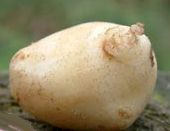
Earth Nut |
The Earth Nut (Bunium flexuosum) is also called Hog Nut, Pig Nut, Jur Nut, St. Anthony's Nut, Earth Chesnut, and Kipper Nut. Caliban says, in the Tempest, "I with my long nails-will dig thee Pig Nuts." They are an excellent diuretic, serving to stimulate the kidneys.
|
Pliny talked of fungi in general as a great delicacy to be eaten with amber knives and a service of silver. But Seneca called them voluptuaria venena. The Russians take some which we think to be deleterious; but they first soak these in vinegar, which (adds Pliny), "being contrary to them neutralizes their dangerous qualities; also they are rendered still more safe if cooked with pear stalks; indeed it is good to eat pears immediately after all fungi." Almost every
species except the common Mushroom is characterized by the majority of our countrymen as a toadstool; but this title really appertains to the large group bearing the subgeneric name of "Tricholoma", which probably does not contain a single unwholesome species. Other rustic names given to this group are "Puckstools" and "Puckfists." They are further known as "Toad skeps" (toad's cap) in the Eastern counties.
Puck, the mischievous king of the fairies, has been commonly identified with pogge, the toad, which was believed to sit upon most of the unwholesome fungi; and the "Champignon" (or Paddock Stool) was said to owe its growth to "those wanton elves whose pastime is to make midnight mushrooms." One of the "toad stoo's" (the Clathrus cancellatus) is said to produce cancerous sores if handled too freely. It has an abominably disgusting odor, and is therefore named the
"lattice stinkhorn." The toad was popularly thought to impersonate the devil; and the toad-stool, pixie stool, or paddock stool was believed to spring from the devil's droppings.
The word Mushroom may have been derived from the French Moucheron, or Mousseron, because of its growing among moss. The chief chemical constituents of wholesome Mushrooms are albuminoids, carbo-hydrates, fat, mineral matters, and water. When salted they yield what is known as catsup, or ketchup (from the Japanese kitchap). The second most edible fungus of this nature is the Parasol Mushroom (Lepcota procera).
Edible Mushrooms, if kept uncooked, become dangerous: they cannot be sent to table too soon. In Rome our favorite "Pratiola" is held in very small esteem, and the worst wish an Italian can express against his foe is "that he may die of a "Pratiola"." If this species were exposed for sale in the Roman markets it would be certainly condemned by the inspector of fungi.
|
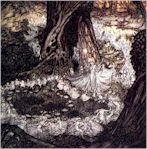
Fairy Ring |
Fairy rings are produced by the spawn, or mycelium, beginning to germinate where dropped by a bird or a beast, and exhausting the soil of carbon, nitrogen, phosphorus and potash, from the centre continuously outwards; whilst immediately within the enlarging ring there is constantly a band of coarse rank grass fed by the manure of the penultimate dead spawn. The innermost starved ground remains poor and
barren. In this duplicate way the rings grow larger and larger. |
Our edible Mushroom is a "Pratella" of the subgenus "Psalliota", and the "Agaricus campestris" of English botanists. In common with the esculent Mushrooms of France it contains phosphate of potassium--a cell salt essentially reparative of exhausted nerve tissue and energy.
The old practice of testing Mushrooms with a silver spoon, which is supposed to become tarnished only when the juices are of an injurious quality (i.e., when sulphur is developed therein under decomposition) is not to be trusted. In cases of poisoning by injurious fungi after the most violent symptoms may have been relieved, and the patient rescued from immediate danger, yet great emaciation will often follow from the subsequent effects of the poison: and the skin may exhibit
an abundant outbreak of a vesicular eruption, whilst the health will remain perhaps permanently injured. Strong alcoholic drinks should never be taken together with, or immediately after eating Mushrooms, or other innocent fungi. Experienced fungus eaters (mycophagists) have found themselves suffering from severe pains, and some swellings through taking whiskey and water shortly after the meal: whereas precisely the same fungus, minus the whiskey, could be eaten with impunity
by these identical experimentalists.
Herb Simples
The Primitive Simplers presented here show the way of life in other generations, it is not suggested or recommended trying them yourself. |
|
Garden
Herbs
Home
History of Herbs
Herb Gardening
Herbs for Beginners
Drying & Preserving Herbs
Indoor Herb Gardening
Herb Garden
Hints & Tips
Herbal
Cooking
Herb Chart
Using Herbs
Culinary Herbs
Herb
Oil and Vinegar
Herb Teas
Herb Candy
Herb Jelly
Herb Simples
Preface
Introduction
Alphabetical Listing

Trade
Recipes Online
Share your Recipes with others!!
|








